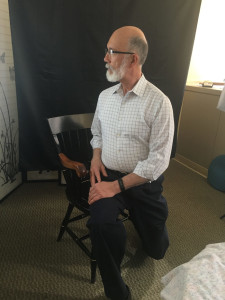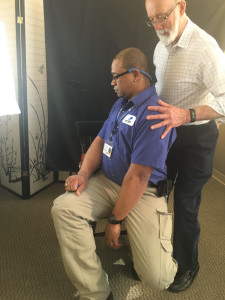A basic movement that we learn very early in our lives is turning. As an infant we use it to roll over from our back to our stomach. It is totally reversible. We have to use this move to roll over in bed, back up a car, golf, and many other activities. It is a simple, basic movement that sometimes becomes problematic.
One specific case that comes to mind is difficulty turning around when walking. This is particularly true with Parkinson’s Disease patients. You can see that they will turn as a single block taking many tiny steps to make a complete turn. This is a common source of instability and falls. I have a whole sequence of segmental movements lying on the side to help develop the skill of turning each body part independently of the other. The accompanying video is the sitting version of turning around.

Another issue is rolling over in bed. People with low back pain frequently report that the pain resulting from rolling over wakes them up and interrupts their sleep. Many times these individuals take a long time to fall asleep due to their back pain, so this is particularly frustrating. They tend to wake up exhausted. This is one reason why the pain persists longer than it needs to. Rolling in bed is the first thing I address to avoid this vicious spiral. It is usually an easy lesson. How do you expect to heal if you don’t get good sleep. There is a short video clip taken from my DVD that demonstrates rolling in bed.
One basic idea about turning is that you need a little slack in your back muscles so they can comfortably allow you to turn. Try this little experiment. Sit up very straight and try turning as if you were looking behind you. Notice how far you can turn. Now slouch and repeat the turn. For the last step find a sitting position that is half way between slouching and arching your back. Repeat the turn. If this middle position is the most comfortable one that allows you to turn, you have discovered two things. One lesson is that muscles that are either too tight ( as in sitting really straight) and too slouched ( too taut ) don’t have enough slack to turn comfortably. Secondly that this position of slack allows you to better move in any direction whether it’s looking down looking up, side bending, or any combination. This is what is called a neutral pelvis. It is the position from which you can move in any direction.
 Here is another little experiment you may want to try. You can practice sitting with the neutral pelvis position as described above. Try turning left and right from a sitting position. Typically one direction is easier than the other. Put one hand on the front of the pelvis. The best point is about belt level and the spot closest to the front. Compare how much this point moves on the side that turns easier. You most likely will sense that there is a relation between the pelvis turning and the torso turning. It is quite obvious once you think of it.
Here is another little experiment you may want to try. You can practice sitting with the neutral pelvis position as described above. Try turning left and right from a sitting position. Typically one direction is easier than the other. Put one hand on the front of the pelvis. The best point is about belt level and the spot closest to the front. Compare how much this point moves on the side that turns easier. You most likely will sense that there is a relation between the pelvis turning and the torso turning. It is quite obvious once you think of it.
To expand the movement of the pelvis you would simply add the next body segment , namely the leg. Sit next to edge of the chair. Start turning your head as if to look behind yourself. Turn until you reach a comfortable end point. Return to facing forward. Next turn your head and ribs. Do this several times. Come back to the starting position. To add the leg simply let one knee drop to the floor as if you were to kneel on it. You get to figure out which knee. It only works one way. Repeat this turning pattern 10 times. Now compare looking over each shoulder just turning your head. You may notice that the side you turned using your whole body is easier. You have learned how to integrate movement for your comfort. This is a practical application of Core Movement Integration. The basic principles of connected and comfortable movement apply to all movements that we use every day. For more examples of Core Movement Integration you may want to purchase my DVD. Have fun exploring how this works for you.